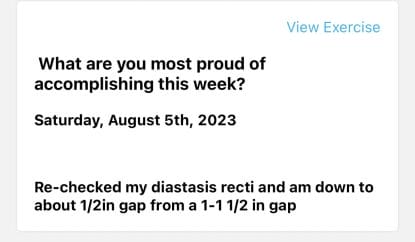Pregnancy is an incredible journey that brings immense joy in a woman’s life. However, it also brings physical changes, including the separation of abdominal muscles known as diastasis recti. This condition affects many women postpartum, causing challenges in core strength and stability. The good news is that exercise can play a pivotal role in helping women recover from diastasis recti and regain their core strength.
What is Diastasis Recti?
Diastasis recti is the separation of the rectus abdominis muscles, commonly known as the “six-pack” muscles, along the linea alba. During pregnancy, as the uterus expands, the pressure within the abdominal cavity causes the muscles to separate. This condition typically becomes noticeable postpartum with symptoms like a visible bulge or “mummy tummy,” weak core muscles, lower back pain, and poor posture.
The Good News – Exercise Can Help!
Exercise can significantly contribute to the healing process of diastasis recti, primarily by re-engaging and strengthening the deep core muscles. Here are some key ways in which exercise helps women see improvements in diastasis recti.
- 1. Targeted Core Strengthening: Specific exercises focused on the transverse abdominis muscle, the deepest layer of abdominal muscles, can help draw the separated muscles back together. These exercises often include pelvic floor exercises, deep abdominal muscle activation, and controlled movements. A qualified fitness professional or physical therapist can provide guidance on proper form and technique to maximize effectiveness.
- 2. Improved Posture and Stability: As diastasis recti weakens the core muscles, it can lead to poor posture and stability issues. Incorporating exercises that target the pelvic floor, deep abdominals, and back muscles can improve overall core strength, enhance stability, and correct posture.
- 3. Mindful Exercise Approach: Adopting a mindful approach to exercise is crucial when dealing with diastasis recti. Women must listen to their bodies, respect their limits, and avoid exercises that place excessive pressure on the abdomen, like crunches or heavy lifting. Gentle and controlled movements, focusing on the quality of contractions rather than quantity, are fundamental for healing diastasis recti safely.
- 4. Gradual Progressive Exercise Routine: Recovering from diastasis recti requires patience and perseverance. It is essential to follow a gradual progression plan that gradually increases exercise intensity, allowing the body to adapt and heal progressively. Starting with gentle low-impact exercises, one can gradually incorporate resistance training and core-strengthening exercises as the condition improves. Consistency and gradual progression will yield better results in the long run.
Check out feedback from one of our clients who has been with us for nearly one year now:

With time, patience, and consistency, women can experience an improvement in their diastasis recti.
We have some wonderful training options available and it all starts with scheduling your free consultation by clicking on the button below!
